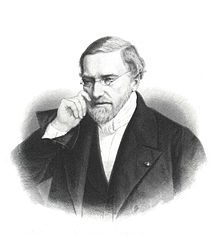Jean-Victor Poncelet
Jean-Victor Poncelet (born July 1, 1788 in Metz , † December 22, 1867 in Paris ) was a French mathematician , engineer and physicist . He was one of the founders of modern projective geometry .
Life
Poncelet studied at the École polytechnique in Paris a . a. at Gaspard Monge . In 1812 he took part in Napoleon's Russian campaign as a lieutenant and engineer . Poncelet was mistakenly left dead in Krasnoy during the Battle of Smolensk (his colonel was killed and his horse was shot away too). The Russians picked him up to interrogate him as an officer and he was taken prisoner of war on November 18 . In a march of over four months in freezing cold over 1500 km he reached Saratov on the Volga , from where he returned to France in 1814 . As a prisoner of war he studied projective geometry and worked out - without being able to use any books - the main features of his main work Traité des propriétés projectives des figures . This is a remarkable analogy to Jean Leray , who in the 1940s in Austrian captivity laid the foundations for new branches of algebraic topology, also as a by-product of teaching fellow prisoners. He himself reported on his experiences in memoirs that were printed in the second edition of his main work in 1862.
From 1815 on he was a military engineer at the Metz Fortress , a teacher at the Ecole d´application, and from 1825 to 1835 professor of mechanics . He improved the efficiency of turbines and water wheels, with the latter increasing by 100 percent . His book Introduction a la mécaniqueindustrie from 1829 consistently uses the concepts of “work” (energy) that are taken for granted today as a product of force and path. He also tries a geometric treatment of mechanical engineering while avoiding analytical developments in order to be understandable in wider circles. In his publication "Traité des propriétés projectives des figures" in 1823 he presented fundamental ideas of projective geometry, such as the invariance of the double ratio, projective relationships, the duality principle, Poncelets continuity principle and the first appearance of imaginary elements in projective geometry. Here, too, he primarily has the multiple applications (technical drawings, etc.) in mind.
Between 1835 and 1848 he was a member of the Commission for the Fortification of Paris and taught mechanics at the Sorbonne in Paris. During this time he was promoted to brigadier general. According to Bell, his talent was buried under a large number of routine jobs - such as the nationwide inspection of all mills - which he dutifully took over. In 1848 he made himself available to the government at the head of his polytechnic students in the turmoil of the revolution. Shortly afterwards he started reforms at the Ecole Polytechnique. He was commander of the École Polytechnique (1848-1850) and commander in chief of the National Guard of the Seine department . In 1850 he retired.
In 1851 Poncelet became President of the Scientific Commission in preparation for the World's Fair in London . From 1832 he was a corresponding member of the Prussian Academy of Sciences . In 1834 he was accepted into the Académie des Sciences in Paris. In 1842 he became a foreign member of the Royal Society . In addition, he was accepted on May 31, 1863 in the Prussian order Pour le Mérite for science and the arts as a foreign member. In 1857 he was elected to the Russian Academy of Sciences in Saint Petersburg and in 1865 to the American Academy of Arts and Sciences .
Poncelet is immortalized by name on the Eiffel Tower, see: The 72 names on the Eiffel Tower . In his honor, was a French unit of power with Poncelet named and awarded the Academie des Sciences the Poncelet Prize . In 1964 the IAU named the lunar crater Poncelet and in 2002 the asteroid (29647) Poncelet after him.
literature
- Eric Temple Bell Men of mathematics , Touchstone books
- Achim Hettler and Karl-Eugen Kurrer : Earth pressure . Ernst & Sohn , Berlin 2019, ISBN 978-3-433-03274-9 , pp. 332–333
Works
- Traité des propriétés projectives des figures . Paris (1822), 2nd edition in 2 vols. 1862, 1865. Digitized version (Service Commun de Documentation de l'Université Louis Pasteur, Strasbourg)
- Mémoire sur les roues hydrauliques verticales etc. Metz (1826)
- Cours de mécanique appliquée aux machines . Metz 1826
- Théorie des mécaniques de la Turbine Fourneyron . Metz (1838)
- Introduction à la mécanique industrial . Metz (1840)
See also
Web links
- Works by and about Jean-Victor Poncelet in the German Digital Library
- John J. O'Connor, Edmund F. Robertson : Jean-Victor Poncelet. In: MacTutor History of Mathematics archive .
- Spektrum .de: Jean-Victor Poncelet (1788–1867) July 1, 2018
Individual evidence
- ^ Die kleine Enzyklopädie , Encyclios-Verlag, Zurich, 1950, Volume 2, page 383
- ↑ The Orden pour le merite for science and the arts, The members of the order , Volume I (1842–1881), page 242, Gebr. Mann-Verlag, Berlin, 1975
| personal data | |
|---|---|
| SURNAME | Poncelet, Jean-Victor |
| BRIEF DESCRIPTION | French mathematician |
| DATE OF BIRTH | July 1, 1788 |
| PLACE OF BIRTH | Metz |
| DATE OF DEATH | December 22, 1867 |
| Place of death | Paris |
